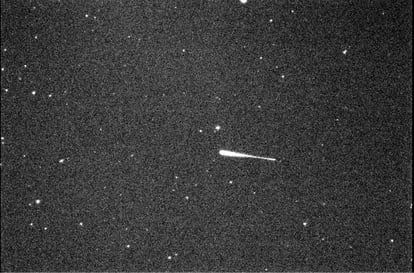The
Long March 5B
rocket
of the Chinese space agency fell in the Indian Ocean at 5.24 Spanish peninsular time, as reported by the Chinese space authority.
Debris that withstood the brutal friction with the atmosphere upon reentering Earth have crashed into the sea near India and Sri Lanka.
The rocket, which took off on April 28, fell uncontrollably since it fulfilled its mission of putting the future Chinese space station,
Tianhe
, into orbit.
. In recent days, all space object tracking organisms followed in detail the evolution of its fall to try to indicate which would be the trajectory and the most probable moment when it would fall on the surface of the planet. Eventually, most of the remains have disintegrated upon entering the atmosphere, and what remains have sunk into the ocean.
The latest calculations by the European authorities, early Saturday night in Spain, indicated that the rocket would hit the Earth in the early morning of Saturday to Sunday around 4:30 a.m. Spanish peninsular time, with more than two hours of margin of error before and after that moment. The estimate at that time from the space surveillance project promoted by the European Union (SST) is that it could fall into the sea near the coast of Australia. "But the uncertainty is still very high, the probability that it will fall there is not even twice that of falling elsewhere," warned Jorge Lomba, head of the CDTI space program and coordinator of the SST. At midnight,both the Russian agency Roscosmos and the US Department of Defense indicated that the Iberian Peninsula would be in full path of entry of the remains and that it could happen off the coast of northern Portugal.
Map 3: Braga, Portugal (0202 UTC);
Valladolid, Spain (0203 UTC), Reus, Spain;
Oristano, Sardinia;
Rosarno, Calabria, Italy;
Kythira (0208 UTC);
Sitia, Crete;
Gaza (0211 UTC);
Jordan;
Riyadh, Saudi Arabia (0214 UTC);
Dhofar, Oman (0217 UTC).
pic.twitter.com/iQGETBTmcP
- Jonathan McDowell (@ planet4589) May 8, 2021
The protocol for these cases indicates that after the estimated time of fall, a sweep is made with three radars to certify that it does not continue orbiting and that the outcome has arrived.
The US uses an infrared satellite to follow the enormous energy that these debris give off when they hit the atmosphere and certify the point of entry.
From the beginning of this incident, it was always considered that the most probable thing was that it fell into the oceans, but there was the least probability that the pieces of the ship would rain on Spain. In one of its multiple orbits, since it circles the planet every 90 minutes, Spanish astronomers from the Bolides and Meteorites Research Network were able to capture its passage from Seville. The video shows how the object glows intermittently, as it reflects light while spinning uncontrollably.
The margin to identify the point of fall was very wide, since the calculations ensured that the rocket (the parts that supported the friction against the atmosphere) could fall between the parallels 40º north and 40º south: from Madrid, Beijing or New York, to the north, or Cape Town (South Africa), Buenos Aires or Santiago de Chile to the south. As it fell to Earth, it was flying at a speed of 28,000 kilometers per hour, rotating on itself in an elliptical orbit, making it difficult to identify the point of collision with the atmosphere, at an altitude of about 80 kilometers.
China had ensured that it was "highly unlikely" that the remains of the rocket caused damage when falling and were betting on its disintegration when hitting the atmosphere, where it can cause temperatures between 3,000º and 10,000º, depending on the angle of entry, the shape or the type of material.
"Most of the debris from the rocket will disintegrate and be destroyed during its re-entry into the atmosphere," said Foreign Ministry spokesman Wang Wenbin.
The image captured by the AROAC-T08 telescope of the European space surveillance network shows the Chinese rocket in its orbit around the Earth.
The Chinese space agency has been widely criticized for its deliberate carelessness in managing these rockets.
Although there is no international regulation to be governed by, the usual practice is to design control systems for reentry into the Earth, such as propellants that allow establishing a trajectory, for objects of more than five tons.
And the
Long March 5B
weighed more than 20 tons.
In May 2020, China launched a twin rocket at it and part of its remains (some large ones) fell on the Ivory Coast, prompting complaints from the United States.
You can follow MATERIA on
,
and
, or sign up here to receive
our weekly newsletter
.

